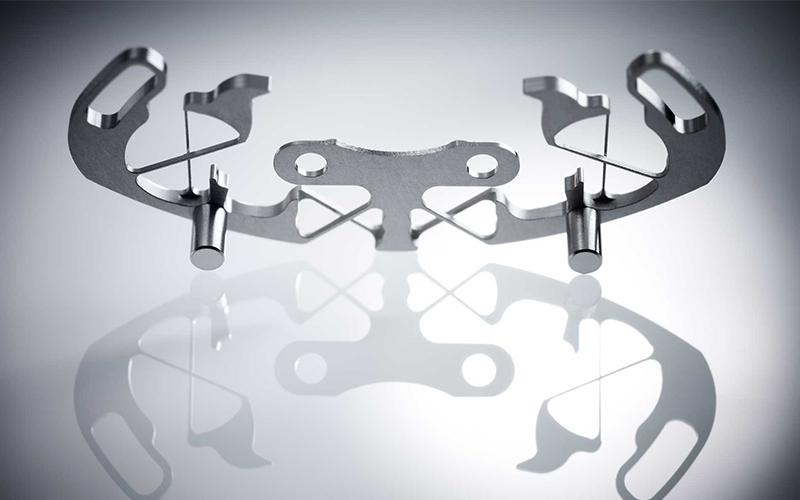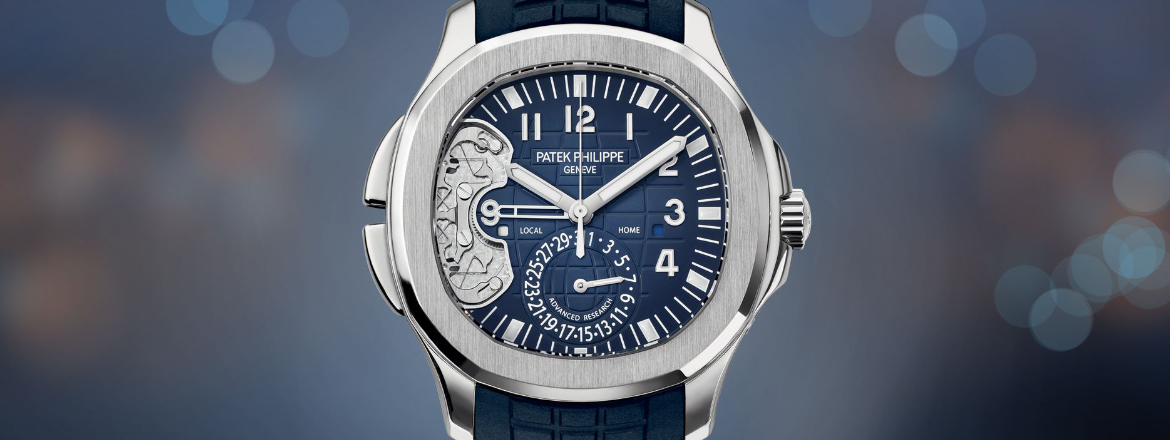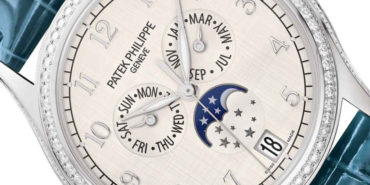New Watch! • 27 Apr 2017
The New Patek Philippe Aquanaut: Getting Advanced At Twenty With The Ref. 5650G!
At this year’s Baselworld, Patek Philippe decided to bestow the Nautilus’ younger brother the honour of front of house with a new enlarged case size, and its very own “Advanced Research” complication. Introduced in 1997, the Aquanaut is coming of age at twenty!
While the larger, white gold and blue dial Aquanaut ref. 5168G is probably this summer’s hot watch, the other Aquanaut (Ref. 5650G) that was released at Baselworld is more significant. It contains a new innovation from Patek Philippe’s Advanced Research department: a new form of spring-based pusher system with a “compliant mechanism”.
In this instance, the pusher system was a design-based approach rather than one based on new materials. And to ensure that the wearer can see the new innovation at work, the watch has a cut-away dial.

The Advanced History
To say that Patek Philippe’s Advanced Research department takes its time with new innovations is a bit of an understatement. That said, testing any movement innovation takes time as it is only over the long run that you actually find out if there are further effects that were not initially predicted. Patek Philippe is not alone in this naturally. Most of its peers, even when it comes to a new, simplistic watch, will have tested it extensively over the long term.
Until the new Aquanaut, the Advanced Research department at Patek Philippe concentrated on introducing silicon into the escapement in a very limited way. Silicon has well known properties that makes it a potentially superior material where surfaces move against each other. Silicon has a harder surface than steel and does not necessarily require oils. There is also the advantage that silcon components can be manufactured with a high degree of precision.

The first step came in 2005 when it introduced the first Patek Philippe silicon component: an escape wheel in Silinvar (a proprietary silicon dioxide formulation) found inside the Annual Calendar ref. 5250. Subsequently Patek Philippe slowly replaced other escapement parts, with two more annual calendar models, until the culmination with a wholly silicon-based escapement in the Perpetual Calendar ref. 5550P in 2011.
Advanced But Compliant
Advanced Research then went dark for the next six years until the announcement at Baselworld earlier this year. Notably the new innovation in the Patek Philippe Aquanaut Travel Time Ref. 5650G “Advanced Research” was a departure on two main counts.
First, the key innovation did not contain silicon. Second, the watch was definitely modern in styling and in the way it showcased the innovation in the watch. Equally, the watch was no longer an annual or perpetual calendar.
Patek Philippe went all out to showcase this innovation with the Aquanaut and with an asymmetric and unusual looking dial. Admittedly, the cutaway dial would not look as appropriate on a more classic watch; so the model choice was a prudent one.
The workings of the innovation are there for all to see. Both pushers perform a very basic function: moving either forward or backwards the “home” time hour display. You can imagine that in years to come variants of the innovation will be applied to a chronograph. We can all take votes on which watch that might appear in!

At the point where any of the pairs of tensile springs cross (forming an “X”) the tolerance is only 150 microns. The mechanism itself, when you actually see it working (through the cut-away dial) is intuitive and you are left wondering why someone did not do something like it sooner. The springs with the end pusher act as one mechanism in advancing the hour hand each hour either up or down. The outer arms with rounded ends secured by screws act as stabilizers to ensure that the pusher part (the “X” spring ending in a beak) does not deviate. It really is obvious and smart – all the pusher levers and springs, pivots and gears, are subsumed into one element. Not surprisingly this cuts down on the number of parts and on maintenance required.

Compared with the usual world time Patek Philippe Aquanaut, where the time zone adjustment mechanism requires 37 parts, the new Advanced Research movement only requires 12. That’s a reduction by a factor of three in the number of moving parts and therefore the amount of wear and tear in the mechanism. According to Patek Philippe, the compliant mechanism is as durable as the traditional one it replaces, having been wear-tested to the same standards.
Research into compliant mechanisms in other industries is well advanced, but Patek Philippe is using the technology for the first time in watchmaking. While new, the innovation relies on steel, good old fashioned thinking, and designing around an existing problem. The compliant mechanism involved considerable computer time and sophisticated CNC machining to create the complex part in steel while keeping it a single, seamless piece. This simple yet high tech approach to innovation is arguably in short supply in the watch industry these days – kudos to Patek Philippe on that.
Importantly, what is both admirable and laudable is the fact that the “compliant mechanism” is finished by hand, with the same surface and edge finishing as traditional components.
New Hairspring
The other innovation in the Advanced Research Patek Aquanaut is the balance spring. This is an evolution of the one contained in the Annual Calendar Advanced Research Ref. 5350 of 2006. The progression is an extremely technical development: the slight increase in thickness on the inner part of the coil (which was already done with the outer part of the coil).
The increase in mass is basically a way of replicating the overcoil part, or terminal curve, of a traditional balance spring made of metal alloy. Patek Philippe now says that because of this reshaping the centre of gravity for the new hairspring is in synchronization with the centre of gravity for the balance. This is exactly what you need to produce a centred expansion and contraction of the balance: and if you have that, you have perfectly accurate time. We are not in a perfect world so the actual timing according to Patek is -1/+2 seconds a day.
Not bad, but given what can be achieved by traditional methods and a timing watchmaker who has the knowledge and the “hands”, not that great either. Rolex now have similar standards on the COSC qualified watches. Perhaps what the new materials bring is the ability to standardize to that kind of accuracy with less variation and less manual regulation.
At the same time, it is curious as to why only the new balance spring was included and not the other silicon parts, namely the Advanced Research balance wheel, pallet fork and escape wheel. If Patek Philippe had already arrived at a certain state of knowledge with the Ref. 5550P, why not include all of that into the latest Advanced Research watch? Seems a strange mix. Or should this now be inferred as the terminal curve properties of the new Silinvar balance spring make the other silicon-based elements redundant?
From the consumer’s point of view, especially someone who owns all Advanced Research limited editions, that is the problem about changing a number factors about a problem all at the same time. It there is no constant in play, you are unsure where the change came from.
While the Patek Aquanaut Advanced Research is a “concept” watch in that it introduces new materials and new ideas, it is also a polarizing watch. The cutaway dial is not for everyone. That said, there is some justification for showing off both the new pusher mechanism and the skill required in finishing such a delicate single innovation. But unlike the other Advanced Research watches that kept the conservatism of Patek Philippe dials firmly to the front of the watch, this one is departure.
The limited edition run for the Aquanaut ref. 5650G is for 500 watches. I am sure that all are sold, or nearly sold. The Advanced Research watches from Patek remain in demand, even for a novelty watch. If nothing else, the ability to see the workings of the new pusher mechanism and its ergonomic efficiency will be enough to induce Patek collectors that this should be a watch in their collection. It will probably prove important in the years to come and will undoubtedly be a conversation piece. It is new; it is beautifully designed and finished; and it is a modern watch from Patek Philippe. It was certainly one of the watches to talk about at Baselworld and that is something of note.
Learn more about the Patek Philippe Advanced Research here.
For more information, please schedule an appointment with our Sales Consultant here.









